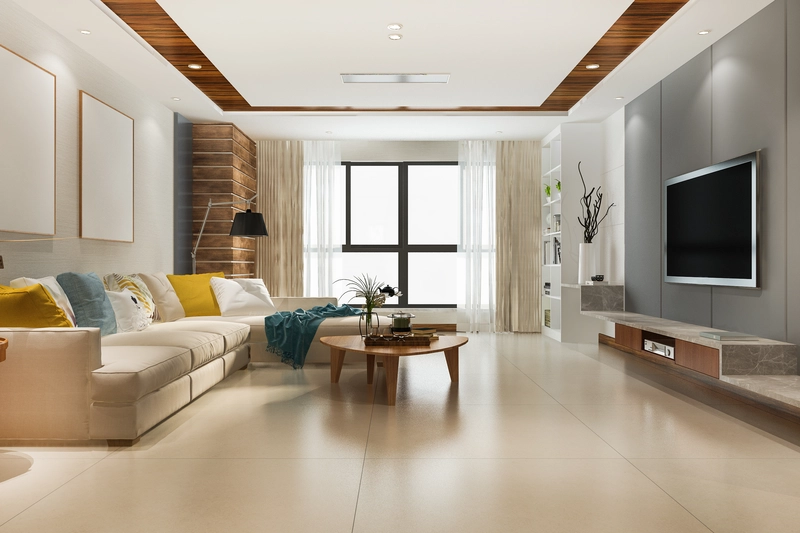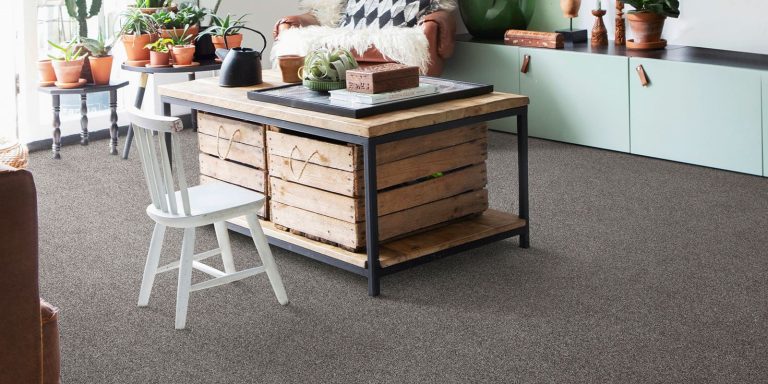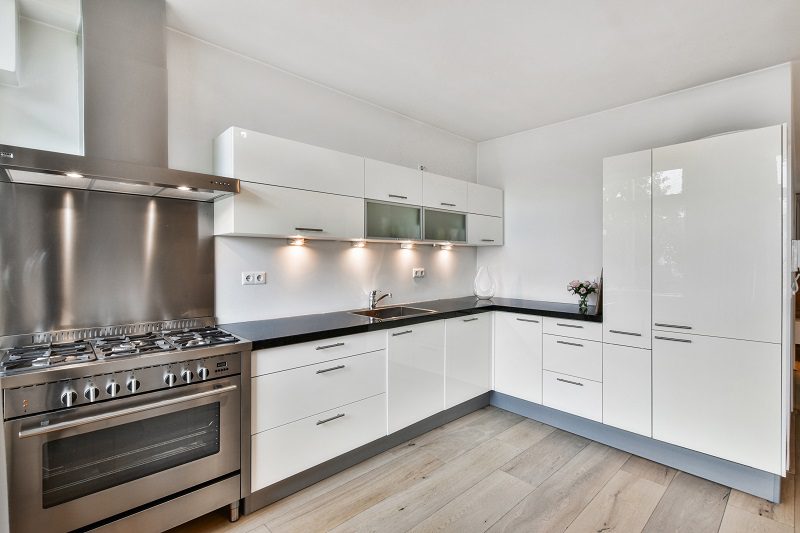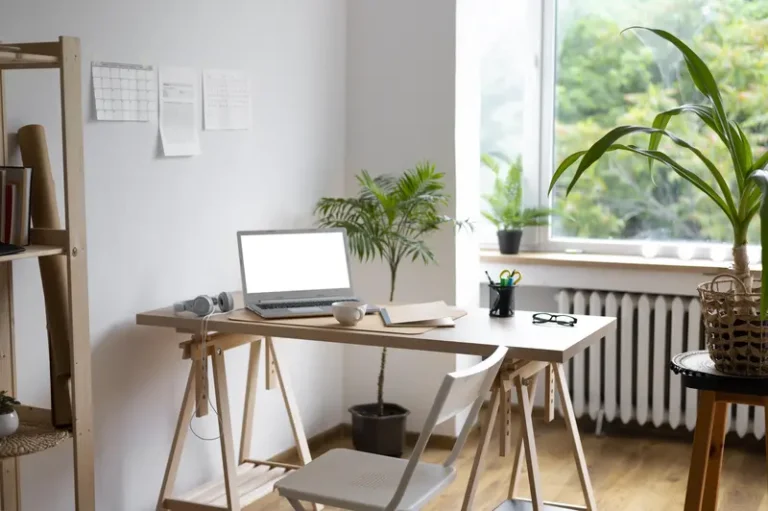Feng Shui, the ancient Chinese practice of arranging spaces to harmonise energy, can transform your living room into a sanctuary of balance and tranquillity. This article explores how Feng Shui living room principles can enhance your space, from ideal layouts and the importance of natural elements to essential dos and don’ts.
Whether you’re seeking a more inviting atmosphere or looking to boost the positive energy in your home, discover practical tips and insights that will help you create a harmonious living room.
What Is Feng Shui?
Feng Shui is an ancient practice rooted in Taoism that focuses on the harmonious arrangement of space to enhance the flow of energy, or qi, within an environment. Essentially, it aims to optimise the positive qi while minimising negative qi, creating an atmosphere conducive to balance, well-being, and prosperity.
By understanding feng shui principles, homeowners can design their living spaces to promote spiritual harmony and a positive atmosphere, thus improving their overall quality of life and fostering a serene environment for relaxation and gathering.
Feng Shui’s Affect for Living Room
The sitting room, often regarded as the heart of a home, plays a crucial role in feng shui as it serves as a space for family gatherings, relaxation, and social interaction.
When feng shui rules are applied to the sitting room, they influence the energy forces within it, fostering a positive atmosphere that enhances well-being and encourages a vibrant social environment.
Proper energy flow creates a harmonious balance that reflects the emotional tone of the household and promotes healing energy, making it essential to prioritise feng shui practices when designing or renovating this essential space.
Feng Shui Living Room Layout Ideas
An ideal layout for a feng shui living room involves thoughtful furniture arrangement, ensuring that all elements harmonise to create a space that promotes positive chi and a comfortable environment.
Central to this layout is the concept of the command position, which places seating in a way that allows for a view of the entrance while still feeling secure and inviting. This layout not only enhances energy flow but also helps balance elements such as natural light, plant life, and decorative accessories, creating a serene environment that nurtures both relaxation and social interaction.
a. The Commanding Position
The commanding position is a fundamental concept in feng shui that dictates how furniture, especially seating, should be arranged in a sitting room to promote positive energy flow and a sense of security. Ideally, the main seating should face the door while being positioned away from direct alignment to it, allowing individuals to feel in control and aware of their surroundings. This strategic placement fosters a welcoming atmosphere that encourages community gathering and nurtures relationships, making it essential for creating inviting spaces that reflect both comfort and positive energy.
To truly enhance the commanding position in your sitting room, focus on the layout of key furniture pieces. Start by ensuring that your sofa or primary seating area is placed against a solid wall for stability, presenting a clear view of the entrance without being directly in line with it. This arrangement offers a harmonious blend of openness and protection, vital for a balanced energy flow.
Consider incorporating side tables to provide convenience and support. Add personal touches, such as art or plants, to create a sense of belonging. Ensure that pathways are clear to allow movement and encourage social interactions.
Remember, creating an inviting space means embracing design that provides comfort while simultaneously inviting positive energy.
b. The Five Elements
The five elements—wood, fire, earth, metal, and water—are integral to feng shui and play a crucial role in achieving balance and harmony within the living room. Each element represents different energies and emotions, and should therefore be incorporated thoughtfully through colours, materials, and decorative accessories. By harmonising these elements, homeowners can create a space that not only enhances the energy flow but also promotes healing energy, ensuring that the living room serves as a tranquil environment conducive to relaxation and emotional well-being.
Incorporating the five elements not only transforms the aesthetic of a room but also influences the emotional atmosphere.
- Wood: Opt for wooden furniture or houseplants to introduce growth and vitality.
- Fire: Use warm colours like red or orange in decorative items, such as cushions or artwork, to evoke enthusiasm and passion.
- Earth: Incorporate ceramic vases or stone decorations that promote stability and grounding.
- Metal: Metal frames or accents can add clarity and precision, thereby fostering a well-structured environment.
- Water: Consider adding a water feature or soothing blue accents to invite tranquillity and abundance.
By thoughtfully selecting decorative choices that embody these elements, homeowners can create not just a visually stunning space but also a sanctuary filled with harmonious energy and emotional balance.
c. The Bagua Map
The Bagua Map is a vital tool in feng shui that assists in identifying areas of energy flow within a space, including the sitting room, and determining how to enhance those energies. By overlaying the Bagua Map onto the sitting room layout, homeowners can pinpoint the zones associated with different aspects of life, such as relationships, health, and career, allowing for targeted enhancements that foster positive home energy. This strategic approach enables individuals to tailor their living spaces to meet their specific needs while creating an atmosphere that encourages spiritual harmony.
To effectively utilise this powerful Bagua Map in your sitting room, start by dividing the space into nine distinct zones, each representing a different area of life. For instance, the relationship section, located at the far right corner, can be enhanced with pairs of decorative items, such as matching lamps or framed photos of loved ones, to symbolise connection and balance.
- Health: For health and well-being improvements, consider incorporating plants, which promote vitality and fresh energy.
- Career: Placing a desk or a mirror strategically can boost confidence and enhance career prospects.
- Prosperity: Add elements like a water feature or vibrant artwork in the wealth zone to attract abundance.
Each enhancement can significantly transform the energy in the room, ultimately supporting personal growth and a harmonious environment.
Feng Shui Living Room Do’s and Don’ts
The dos and don’ts of a feng shui living room provide valuable guidelines for homeowners seeking to create a space that promotes positive energy and well-being.
Among the essential dos is the incorporation of natural light and indoor plants, which help to enhance energy flow and create a fresh atmosphere. Conversely, avoiding clutter is critical to maintaining a serene environment, as it obstructs the positive chi and can lead to feelings of stress and chaos.
Understanding these guidelines can significantly impact the emotional tone of the living room, fostering a vibrant and inviting atmosphere for family and guests alike.
a. Do: Use Natural Light
In feng shui, utilising natural light in the living room is highly encouraged as it enhances energy flow and contributes to a positive atmosphere.
Natural light not only brightens up the space but also promotes feelings of openness and tranquillity, making the room feel more inviting and warm.
By strategically positioning furniture to maximise sunlight exposure, homeowners can create a vibrant environment that uplifts the spirit and nourishes the emotional tone of the living space.
Incorporating natural light effectively involves making thoughtful choices in design and layout. For instance, opting for sheer window treatments allows sunlight to filter in while maintaining privacy. Placing mirrors across windows can also reflect light deeper into the room, enhancing illumination and energy.
A well-lit living room can significantly enhance emotional well-being by reducing feelings of depression and anxiety. Natural light boosts productivity and creativity, turning your living area into a sanctuary of inspiration.
As light transitions throughout the day, a dynamic ambience is created, fostering connections among family members or guests, thereby revitalising the overall atmosphere of the home.
b. Don’t: Have Clutter
Having clutter in the living room is a common pitfall in feng shui that can lead to negative chi and disrupt the energy flow, ultimately affecting the inhabitants’ emotional well-being. Clutter not only obstructs the physical space but can also create mental chaos, eliciting stress and anxiety in those who enter. Therefore, effective space-clearing techniques should be employed to maintain a serene and organised environment, allowing for positive energy to circulate freely and enhancing the overall atmosphere of the living room.
When the living room is overwhelmed with belongings, it can significantly impact the emotional tone of everyone who resides or visits. The accumulated items serve as reminders of past experiences or unresolved issues, dragging down the overall vibration of the space.
To combat these negative effects, consider the following tips for effective space clearing:
- Begin with a deep clean, removing items that are no longer useful.
- Organise belongings into categories, setting aside what can be donated or discarded.
- Utilise storage solutions that are both functional and aesthetically pleasing, ensuring that everything has its designated place.
- Incorporate plants or natural elements to enhance positive energy and improve air quality.
- Make use of mirrors to amplify light and create a sense of expansive space.
By fostering a clutter-free living environment, one can not only invite positive chi but also nurture a sense of calm and well-being for all inhabitants.
c. Do: Incorporate Plants
In feng shui, incorporating plants into the living room is highly beneficial as they promote healing energy and enhance the overall ambience of the space. Indoor plants not only purify the air but also symbolise growth and vitality, creating a sense of life and balance within the environment. By selecting the right types of plants, homeowners can harness positive chi and contribute to a vibrant and nurturing atmosphere that supports well-being and tranquillity.
By strategically integrating plants into the living area, individuals can tap into the ancient practice of feng shui, which emphasises the importance of energy flow. Acknowledging that every plant has unique characteristics, it is essential to choose those that resonate with the desired energy of the space.
For instance, peace lilies and snake plants are renowned for their air-purifying qualities, while pothos and rubber trees are believed to attract abundance and prosperity. To optimise their impact, consider the following tips:
- Placement: Position plants in the corners of the room to uplift energy or near windows for optimal sunlight.
- Variety: Mix types of plants to create diversity, which symbolises prosperity.
- Maintenance: Ensure the plants are well cared for, as healthy plants promote positive vibes.
With thoughtful selection and arrangement, plants can significantly enhance the liveliness and wellness of any living space.
d. Don’t: Have Sharp Corners
Sharp corners in the living room can create negative energy, or sha chi, which can be detrimental to the emotional tone and overall atmosphere of the space. These angles can generate feelings of discomfort and unease, disrupting the flow of positive chi.
To effectively counteract this energy, it is essential to adopt a holistic approach that encompasses various elements within the room. An inviting atmosphere can be achieved by optimising furniture placement; for instance, arranging sofas and chairs in a circular or semi-circular layout not only promotes interaction but also diminishes the impact of sharp angles.
- Accentuate with Round Decor: Incorporate round or oval furniture pieces, such as coffee tables or side tables, to further soften the space.
- Utilise Plants: Strategically place lush greenery to help absorb negativity and enhance comfort.
- Employ Soft Fabrics: Use cushions, throws, and curtains with soft textures and curves to create a sense of warmth.
By implementing these strategies, one can transform a potentially harmful environment into a sanctuary of relaxation and positive energy, ensuring that every aspect of the room invites comfort.
e. Do: Use Calming Colours
Utilising calming colours in the living room is essential in feng shui as they significantly influence the emotional tone and overall atmosphere of the space. Soft, muted shades such as blues, greens, and neutrals can create a sense of tranquillity, promoting relaxation and comfort. By integrating these colours through wall paint, furniture, and decorative accessories, homeowners can foster a positive environment conducive to family gatherings and serene moments.
Incorporating these colour schemes not only enhances the aesthetic appeal but also supports mental well-being.
For instance, blue hues evoke feelings of calmness and peace, reminiscent of the sky and sea, and are perfect for spaces where one unwinds after a long day. Similarly, soft greens can mimic the natural world, instilling a sense of balance and connection, which is transformative in home settings. Using neutrals, especially warm shades, can create a cosy atmosphere, making the room feel inviting and secure.
- Choosing the right colour palette can:
- Impact mood positively
- Enhance social interactions
- Encourage restful sleep
Thus, making thoughtful decorative choices in harmony with feng shui principles not only beautifies the living space but also cultivates a nurturing environment for its inhabitants.
Feng Shui Living Room Rules
Feng shui rules for a living room serve as guidelines for optimising the space to enhance the flow of positive energy and create a harmonious environment. These rules encompass various aspects, including the balance of elements, effective furniture placement, and the importance of home organisation.
By adhering to these principles, homeowners can cultivate a living room that promotes tranquillity, community gathering, and a welcoming atmosphere, ensuring that the space serves its purpose as a hub for family interactions and relaxation.
1. Balance the Elements
Balancing the elements in the living room is crucial in feng shui, as it ensures that each component contributes to a harmonious energy flow within the space. This involves incorporating the five elements—wood, fire, earth, metal, and water—in a proportionate manner to create a balanced environment. By doing so, homeowners can foster a sense of serenity and promote positive energy, making the living room a nurturing retreat for family and guests alike.
To achieve this balance effectively, one might consider the following practices:
- Wood: Utilise plants or wooden furniture to symbolise growth and vitality.
- Fire: Introduce candles or vibrant colours to evoke warmth and passion.
- Earth: Incorporate stones or earthy tones to create stability and grounding.
- Metal: Add metallic accents or decor for clarity and precision in the design.
- Water: Use mirrors or water features to enhance flow and abundance.
Integrating these elements in balanced proportions not only enhances the aesthetic appeal of the living room but also cultivates an atmosphere that is inviting and nurturing, encouraging open communication and relaxation among all who enter.
2. Keep the Energy Flowing
Maintaining a smooth energy flow in the sitting room is a key principle of feng shui that enhances the overall atmosphere and invites positive chi into the space. This involves thoughtful furniture arrangement that allows for easy movement and interaction, avoiding any blockages that could hinder energy circulation. By prioritising energy flow, homeowners can create an inviting and lively environment that encourages community gathering and positive emotions.
To ensure a harmonious setup, consider these practical tips when arranging furniture:
- Position key furniture: Place seating in a circular or U-shape to foster conversation and connection.
- Keep pathways clear: Maintain clear walkways by avoiding clutter and ensuring that large pieces do not obstruct movement.
- Utilise natural light: Arrange furniture to maximise access to natural light, enhancing the mood and vitality of the room.
Emphasising these elements not only promotes a positive atmosphere but also contributes to an overall feeling of warmth and belonging, making the sitting room an inviting space for family and friends.
3. Create a Welcoming Entrance
Creating a welcoming entrance to the living room is essential in feng shui, as it sets the tone for the entire space and influences the home energy. A well-designed entrance invites positive chi and encourages a sense of comfort and hospitality for both residents and guests. This can be achieved through the strategic placement of furniture, and decorative accessories, and the use of vibrant colours that draw people in, creating an inviting atmosphere that promotes connection and warmth.
To effectively enhance the entrance, consider the following practical tips that can transform an ordinary entryway into a captivating welcome.
- Utilise natural light: Natural light plays a crucial role in creating warmth. Utilise sheer curtains or strategically place mirrors to amplify sunlight and invite positivity.
- Choose inviting colours: Warm shades, such as soft yellows or earthy tones, can evoke feelings of comfort. A well-chosen colour palette can make the entrance feel friendly and cohesive.
- Incorporate greenery: Adding plants not only improves air quality but also brings life into the space. Opt for low-maintenance indoor plants that thrive in varying light conditions.
By taking these elements into account, one can cultivate an entrance that not only captures attention but also nurtures a sense of belonging and ease.
4. Use Appropriate Furniture Placement
Appropriate furniture placement is a fundamental aspect of feng shui that directly affects the energy flow and overall comfort of a living room. Ensuring that seating is arranged to promote conversation and connection without obstructing pathways is essential for creating a harmonious space. By prioritising comfortable seating and strategic placement, homeowners can enhance the living room’s functionality and energy, fostering a serene environment that encourages relaxation and social interactions.
The arrangement of furniture plays a pivotal role in setting the tone and ambience of a room. When optimising furniture placement, it’s crucial to consider the following:
- Seating Arrangement: Position chairs and sofas in a way that facilitates easy interaction. Avoid placing furniture with its back to the entrance, as this can create a sense of unease.
- Pathways: Maintain clear paths between furniture to allow for smooth movement, which promotes positive energy flow.
- Comfort: Invest in cosy cushions and throws to enhance the seating experience, making the living room inviting for guests.
Ultimately, thoughtful furniture arrangement not only enhances the aesthetic appeal of a room but also contributes to a welcoming social atmosphere, thereby enriching the overall living experience.
5. Incorporate Personal Touches
Incorporating personal touches into the living room is a vital feng shui principle that enhances the emotional tone and creates a sense of belonging and comfort. Personal decor accessories, such as family photos, art collections, or sentimental items, can foster an inviting atmosphere and improve the overall energy flow. By surrounding themselves with meaningful elements, homeowners can create a space that resonates with their personality and promotes positive chi, ensuring that the living room reflects their unique identity.
Adding thoughtful decorations not only makes a room feel cosier but also encourages a deeper connection with the space. For example, handmade crafts from personal experiences or travel souvenirs can evoke cherished memories, serving as reminders of joyful times. Such meaningful decor holds the power to influence emotional well-being significantly.
Here are a few suggestions for enhancing your living room with personal touches:
- Family Photographs: Create a gallery wall featuring framed moments that tell your story.
- Art Collections: Showcase pieces that resonate with your values and passions, serving as conversation starters.
- Sentimental Items: Incorporate mementoes from significant life events to foster a sense of history and belonging.
By embracing individuality through these enhancements, one can achieve a harmonious balance in their living space.
Integrating the Right Flooring Colour into the Living Room Feng Shui
Choosing the right flooring colour can significantly impact the energy, or “Chi,” of your living space. Here’s how to integrate the right flooring colour into your living room Feng Shui:
1. Understanding the Five Elements
In Feng Shui, the five elements—Wood, Fire, Earth, Metal, and Water—are key to creating a harmonious environment. Each element is associated with specific colours that can be incorporated into your flooring to balance the energy in your living room.
2. Light Wood Floors for Wood Energy
Light wood flooring, such as bamboo or light oak, brings the energy of the Wood element. This is ideal for fostering growth, vitality, and family harmony. Light wood tones are especially effective in the east and southeast areas of the living room, which are associated with health and wealth.


See product: Karndean LooseLay Longboard Bleached Tasmanian Oak
3. Warm Tones for Fire Energy
Flooring with warm tones, like rich cherry wood or terracotta tiles, introduces Fire energy, symbolising passion, energy, and warmth. This is suitable for the south area of the living room, enhancing fame and reputation.


See product: Karndean Art Select Oak Royale Spanish Cherry
4. Earth Tones for Stability
Flooring in earth tones, such as beige, clay, or light brown, brings the grounding energy of the Earth element. It promotes stability, nourishment, and protection. These colours are beneficial in the centre and southwest parts of the living room, supporting relationships and overall well-being.


See product: Cormar Carpet Primo Ultra Cotswold Clay
5. Metallic Finishes for Clarity
Incorporating metallic finishes or grey-toned flooring can enhance the Metal element, representing precision, clarity, and efficiency. Light grey or whitewashed floors can be used in the west and northwest areas of the living room to enhance creativity and support helpful people and travel.


See product: Abingdon Rustique Silver Birch
6. Dark Floors for Water Energy
While lighter colours are generally preferred for the flooring to brighten the space, incorporating dark floors, like dark stained wood or deep navy tiles, can bring the Water element. This is particularly beneficial in the north area of the living room, encouraging career opportunities and the flow of wealth.


See product: Luvanto Click Plus Black Ash
7. Balance and Harmony
Balance is crucial in Feng Shui. If you choose a dominant flooring colour associated with one element, balance it with decor and furnishings that introduce the other elements. For example, if you have light wood floors, complement them with touches of earth-toned rugs, metallic accents, or warm-coloured cushions.
8. Natural Materials
Opt for natural flooring materials whenever possible, as they align better with Feng Shui principles. Natural materials such as wood, stone, and bamboo create a more harmonious and balanced environment compared to synthetic options.


See product: Floorify Big Tiles Terrazzo
Integrating the right flooring colour into your living room Feng Shui involves understanding the elements and how they influence your space. Light wood for vitality, warm tones for energy, earth tones for stability, metallic finishes for clarity, and dark floors for flow can all play a role in creating a balanced and harmonious living room. By thoughtfully selecting and balancing these colours, you can enhance the positive energy in your living space, promoting well-being and harmony.
In conclusion, incorporating Feng Shui principles into your living room can significantly enhance the harmony, balance, and overall energy of your home. But remember, the foundation of any room is its flooring, and choosing the right material is crucial for both aesthetics and energy flow.
For high-quality flooring that compliments your Feng Shui efforts, consider Teka Flooring. Their extensive selection of beautiful, durable options will help you achieve the perfect balance in your living room. Visit Teka Flooring today to explore their offerings and take the first step towards transforming your living space into a sanctuary of peace and prosperity.
Read also:

































